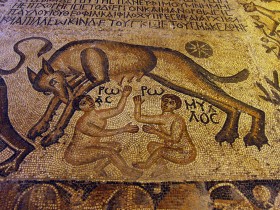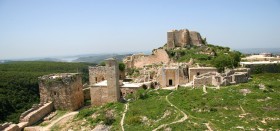Introducing the Manar al-Athar Open Access Photo Archive
The Manar al-Athar photo-archive’s ca. 3,000 photographs of floor mosaics show how classical imagery and motifs were re-purposed in Christian and Jewish buildings, such as the Roman wolf with Romulus and Remus […]
7 Things You Should Know About ASOR’s Syrian Heritage Initiative
Beginning August 4, the American Schools of Oriental Research entered into a cooperative agreement with the U.S. Department of State to monitor, document, and report on cultural heritage damage in Syria.
Artifacts of Unknown Origin: A Conservation Perspective
In the above video, trained conservator and ASOR Manager of Programs and Events LeeAnn Barnes Gordon gives herASOR Annual Meeting paper, “Artifacts of Unknown Origin: A Conservation Perspective.” A primary objective of archaeological conservation is the preservation of archaeological materials for the future. Conservation activities may sometimes play an integral role in the acquisition, authentication, […]
Archaeological Conservation at ASOR
Author: LeeAnn Barnes Gordon For the past two years, my colleague, Suzanne Davis, Associate Curator and Head of Conservation for the Kelsey Museum of Archaeology at the University of Michigan, and I have organized a session at the ASOR Annual Meeting on the topic of archaeological conservation. We were quite pleased that our session, Conservation […]
Archaeology in Lebanon Today: Its Politics and Its Problems
By: Hélène Sader Lebanon has a long and very rich past, but in spite of the country’s wealth of ancient settlements, compared to neighboring countries archaeological research is far behind. While in the last decades archaeological research has greatly enhanced our understanding of Syria’s, Jordan’s, and Palestine’s past, Lebanon appears to be lagging behind and […]
The Virtual World Project: Touring The Ancient World
By: Ronald A. Simkins and Nicolae Roddy, Creighton University There is nothing quite like teaching at an archaeological site, where ancient remains almost speak out to students as witnesses of the past. Both authors have led study tours in Israel, taking students to archaeological sites like Tel Dan, Bethsaida, Megiddo, Arad, Beer-sheba, and others, lecturing […]
iPads in the Field and Reflections on Archaeology’s Digital Future
By: William Caraher, University of North Dakota This past summer my excavation on Cyprus experimented with using iPads to document our excavations in the field. Since, I have co-directed the Pyla-Koutsopetria Archaeological Project with Prof. R. Scott Moore of Indiana University of Pennsylvania and Prof. David K. Pettegrew of Messiah College. Over this time, […]
Sustainability at Any Price is not Sustainable: Open Access and Archaeology
By: Eric Kansa, UC Berkeley This blog post looks at the open access debate, and notes how sustainability is as much of an ideological and political question as it is a financial issue. It is intended to follow up on previous blog posts (first, second, third) that discuss how the Aaron Swartz prosecution […]
Archaeology after the Arab Spring
By: Jesse Casana The transformative political events in the Middle East over the past two years have had, among many other unexpected outcomes, profound effects on the direction of research in Near Eastern archaeology. War and civil unrest act as both a carrot and a stick, forcing the cessation of fieldwork in some areas, while […]
Archaeology and Cultural Heritage in Egypt after Mubarak
By: Greg Williams Egypt’s January 25th revolution was originally seen as part of the larger “Arab Spring” across the Middle East where old political regimes were overthrown by popular protests and replaced by representative democracies. But on January 28th, as chaos reigned in Cairo’s Tahrir Square, reports began circulating around the globe claiming that […]
The Cultural Afterlife of Mosaics in Turkey
By: Laurent Dissard, University of Pennsylvania Sensational discoveries of mosaics periodically make the headlines of newspapers in Turkey. After being discovered, unearthed, cleaned, and removed, these ancient floors slowly make their way to museums or private collections. For this month’s ASOR Blog on the Archaeology of Anatolia, I wish to examine the curious afterlife of mosaics […]
The Gordion Furniture Project
By: Krysia Spirydowicz, Associate Professor, Art Conservation Program, Queen’s University, Kingston, Ontario, CANADA and Senior Conservator, Gordion Furniture Project, Ankara, TURKEY The ancient Phrygian capital of Gordion in central Anatolia was first explored in the early 1950s by a team from the University of Pennsylvania Museum of Archaeology and Anthropology. Located approximately 100 km southwest […]



